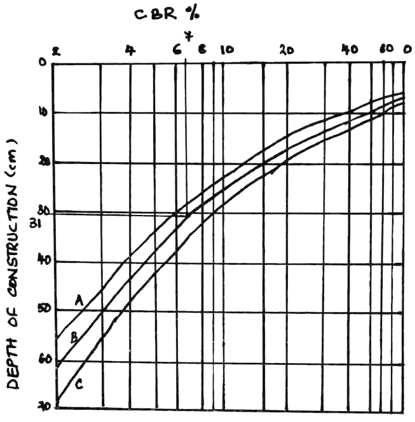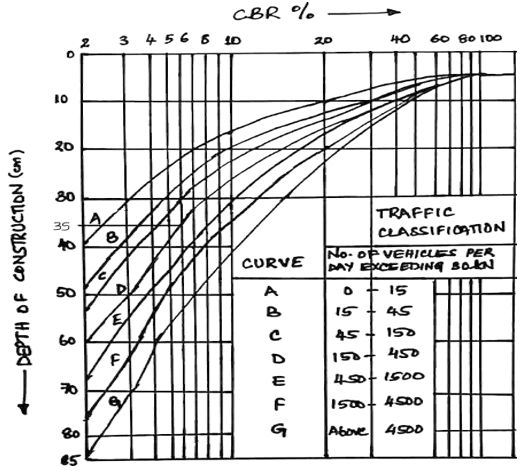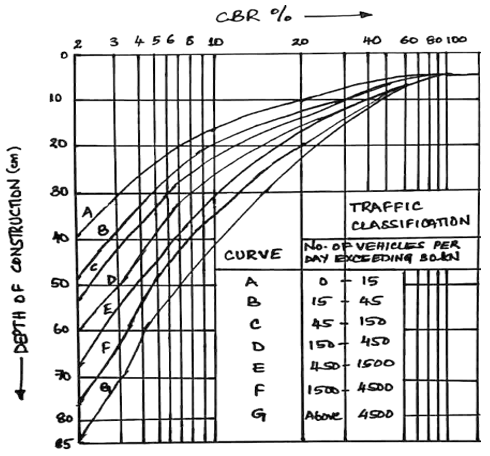This set of Pavement Design Multiple Choice Questions & Answers (MCQs) focuses on “Highway Pavements Design – CBR Method”.
1. ______ proposed the original curves for the design of flexible pavements using CBR method.
a) H. M. Westergaard
b) F. M. Hveem
c) O. J. Porter
d) D. J. Steel
View Answer
Explanation: The original curves for developing the design curves for the flexible pavement using CBR method was first proposed by O. J. Porter. H. M. Westergaard put forward the analysis for rigid pavements, F. M. Hveem developed a method for the mix design of bituminous mixes and D. J. Steel proposed the use of soil classification for design.
2. The equation \(t=\sqrt P (\frac{1⋅75}{CBR}-\frac{1}{pπ})^{1⁄2}\) is valid only when the value of CBR is ______
a) More than 15%
b) Less than 15%
c) More than 12%
d) Less than 12%
View Answer
Explanation: The equation \(t=\sqrt P (\frac{1⋅75}{CBR}-\frac{1}{pπ})^{1⁄2}\) was proposed by US Corps of Engineers to determine the thickness of pavement based on the CBR value. This equation is only valid for a CBR value of less than 12%. They had developed it for values of CBR ranging from 10-12%.
3. How are the traffic volume considerations in the design chart developed by IRC denoted as?
a) Alphabets
b) Alphanumeric
c) Numeric
d) Percentages
View Answer
Explanation: The traffic volume in the design charts by IRC is denoted using alphabets ranging from A to G. A has the least traffic volume and it increases with G having the highest.
4. Which of the below is not a classification of traffic condition that is used in the CBR design chart?
a) Normal traffic 2500 kg
b) Light traffic 3175 kg
c) Medium traffic 4082 kg
d) Heavy traffic 5433 kg
View Answer
Explanation: The design charts developed for CBR method by the California State of Highways makes use of three traffic conditions. They are light traffic, medium traffic and heavy traffic. There is no condition of normal traffic used in the design charts.
5. Calculate the total thickness of the pavement if the CBR value of the soil is 7%, the wheel load is 4100 kg and the tyre pressure is 7 kg/cm2.
a) 2896 mm
b) 28.96 cm
c) 2896 cm
d) 28.96 mm
View Answer
Explanation: The CBR value can be found out using the equation \(t=\sqrt P (\frac{1⋅75}{CBR}-\frac{1}{pπ})^{1⁄2}\) according to the conditions given in the question.
CBR = 7%, P = 4100 kg and p = 7 kg/cm2
\(t=\sqrt{4100}(\frac{1⋅75}{7}-\frac{1}{7π})^{1⁄2}\) =28.96 cm
6. Determine the thickness of the pavement if the pavement is subjected to medium traffic and the CBR value is obtained as 7%.
a) 33 cm
b) 31 cm
c) 35 cm
d) 34 cm
View Answer
Explanation: The data given in the question is traffic condition and CBR value. The California State of Highways design chart is to be used. A sample of the same graph is given below. In the graph, curve A represents 3175 kg wheel load or light traffic, curve B represents 4082 kg wheel load or medium traffic and curve C represents 5443 kg wheel load or heavy traffic. The value corresponding to medium traffic and 7% CBR can be obtained from the chart as 31 cm.

7. IRC 37-1984 redesigned the CBR charts based on ______
a) Wheel loads
b) Cumulative load
c) Design traffic
d) Cumulative standard axle
View Answer
Explanation: IRC 37-1970 used the design chart similar to that developed by the California State Highways, using the CBR value and the traffic volume. Later the charts were redesigned based on the cumulative standard axle (csa) and CBR value.
8. The CBR value of the soil is found out to be 6% and the traffic is 350 commercial vehicles per day. Find the pavement thickness using design charts provided by IRC.
a) 37 cm
b) 35 cm
c) 33 cm
d) 30 cm
View Answer
Explanation: A sample of the design chart for computing the thickness of pavement using CBR method by IRC is shown below. The curve D is to be considered as the commercial vehicles per day is 350 which lies between 150 and 450. The thickness corresponding to 6% CBR and curve D is obtained as 35 cm.

9. Calculate the total thickness of the pavement using the equation given by US Corps of Engineers if the CBR value of the soil is 13%, the wheel load is 4100 kg and the tyre pressure is 6.5 kg/cm2.
a) Not possible
b) 0
c) 18.74 cm
d) 1874 mm
View Answer
Explanation: \(t=\sqrt P (\frac{1⋅75}{CBR}-\frac{1}{pπ})^{1⁄2}\) is the equation given by the US Corps of Engineers to find the thickness of pavement. But this equation is valid only when the CBR value is less than 12%. In the question, it is 13%, so the thickness cannot be found out using this method.
10. As per IRC 37-2012, only the total thickness of the pavement can be found out using the design charts.
a) True
b) False
View Answer
Explanation: IRC 37-2012 has been revised and the thickness of various layers can be found out using the design charts if the CBR value and the csa are known. IRC 37-2001 was the revision that first used this type of design chart.
11. What would be the csa for a two-lane divided pavement with the following details?
Initial traffic in the year of completion, A = 3000 CVPD
Vehicle damage factor VDF, F = 4.5
Design life, n = 20 years
Annual traffic growth rate, r = 5%
a) 305498.42
b) 152749.21
c) 76374.61
d) 38187.30
View Answer
Explanation: \(N=\frac{365[(1+r)^{n}-1]}{r}×A×D×F\) is the equation to compute the csa. The term D in the equation represents the lane distribution factor and is obtained as 0.75 for a two-lane divided carriageway as per IRC 37-2012. The initial traffic must be taken as 1500 CVPD per direction.
\(N=\frac{365[(1+0.05)^{20}-1]}{0.05}×1500×0.75×4.5=152749.21 csa\)
12. The VDF for hilly terrain and initial traffic volume of 150-1500 CVPD is taken as 1.
a) True
b) False
View Answer
Explanation: As per IRC 37-2012, the indicative VDF values have been given in table 4.2. There are two terrains considered – rolling or plain terrain and hilly terrain. VDF for hilly terrain with 150-1500 CVPD is given as 1.5.
13. A flexible pavement has 34505678.91 csa and a CBR value of 4%. What would be the thickness of the base course of the pavement?
a) 250 mm
b) 330 mm
c) 130 mm
d) 300 mm
View Answer
Explanation: Using the design charts given in IRC 37-2012, the thickness of various layers can be found out. The csa must be converted to msa i.e. million standard axle in order to read the design charts. So, 34505678.91 csa would correspond to 34505678.91×10-6 msa i.e. 34.51 msa. The design chart for 4% CBR can be looked up in IRC 37-2012 under the title Plate 2. The thickness of based courses is 250 mm for 30 msa as well as 50 msa, therefore there is no need to interpolate the thickness of base course for 34.51 msa.
14. Compute the pavement thickness using the equation for CBR value of 10%, wheel load of 4100 kg and tyre pressure of 6.5 kg/cm2.
a) 23.43 cm
b) 22.73 cm
c) 24.33 cm
d) 27.23 cm
View Answer
Explanation: The equation to be used is \(t=\sqrt P (\frac{1⋅75}{CBR}-\frac{1}{pπ})^{1⁄2}\) by the US Corps of Engineers. After substituting the values for CBR as 10%, wheel load P as 4100 kg and tyre pressure p as 6.5 kg/cm2 in the above equation, we get the thickness as:
\(t=\sqrt{4100}\left(\frac{1⋅75}{10}-\frac{1}{6.5π}\right)^{1⁄2}\)=22.73 cm
15. What would be the thickness for the pavement if the CBR value of the soil is found out to be 20% and the traffic is estimated to be 4300 commercial vehicles per day?
a) 30 cm
b) 20 cm
c) 22 cm
d) 25 cm
View Answer
Explanation: The design chart as per IRC method is used to compute the thickness. a sample of the same graph is shown below. 4300 CVPD indicates that the curve F should be used. For CBR 20% and curve F, the thickness is obtained as 20 cm.

Sanfoundry Global Education & Learning Series – Pavement Design.
To practice all areas of Pavement Design, here is complete set of 1000+ Multiple Choice Questions and Answers.
If you find a mistake in question / option / answer, kindly take a screenshot and email to [email protected]
- Check Civil Engineering Books
- Practice Civil Engineering MCQs
- Check Pavement Analysis and Design Books
- Apply for Civil Engineering Internship
